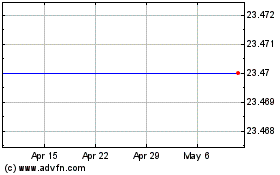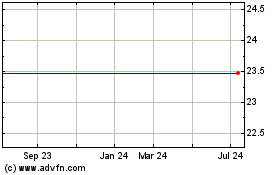Trading At Banks Turns 'Grim'
March 16 2016 - 3:03AM
Dow Jones News
(FROM THE WALL STREET JOURNAL 3/16/16)
By Justin Baer
The calendar may say Wall Street's busy season is well under
way, but for bank traders, it still feels like a chilly
December.
"We're clearly not seeing that normal seasonality," Jonathan
Pruzan, Morgan Stanley's finance chief, said to explain the lack of
the usual first-quarter bump during an investor conference in
London.
In other words, another senior bank executive said: "It's
grim."
As the forecasts roll in, the reasons for the downbeat attitude
are clear enough. The first quarter is typically the most active on
Wall Street trading desks, asbig investors like hedge funds put
their money to work.
Instead, it is shaping up to be a lot more like the
disappointing final months of 2015, when concerns over economic
growth and commodities prices left trading activity and revenue
slumping for major banks.
Two big Wall Street firms -- Morgan Stanley and Jefferies Group
LLC -- gave new details on the depths of the first-quarter problems
Tuesday.
Jefferies, a unit of Leucadia National Corp., swung to a loss
during its first quarter ended Feb. 29, as trading revenue tumbled
and the firm took two unusual hits to its normally solid
equities-trading business.
Morgan Stanley, meanwhile, said that first-quarter revenue this
year was tracking closer to the fourth quarter of last year's,
normally a much weaker quarter for bank trading revenue than the
first quarter, in various markets.
On Tuesday, Morgan Stanley shares fell 1.9%, while Leucadia's
dropped 5.7%
Analysts from Credit Suisse Group AG predicted that the five
biggest Wall Street banks would report trading revenue of $19.1
billion for the first quarter, down 16% from a year earlier.
Analysts at UBS Group AG said this year is shaping up to be the
worst first quarter in trading revenue in at least seven years.
Last year, the first quarter proved to be a high-water mark for
2015. Among large banks, trading revenue of $23.7 billion in the
first quarter made up about 32% of the year's annual trading
revenue of $73.1 billion, said UBS analyst Brennan Hawken. By the
end of last year, sentiment on trading had soured to the point that
Morgan Stanley moved to lay off 25% of its debt traders and
salespeople in December.
Volatile markets prompted corporate clients to postpone stock
offerings early this year, crimping Wall Street's
investment-banking business as well. That makes a quarterly rebound
even less likely.
Jefferies executives said Tuesday that trading conditions
improved in March, after the close of the bank's Feb. 29
quarter.
"While we are early in the quarter and one can never predict the
future, it appears markets have not only stabilized, but
aggressively snapped back," Chief Executive Rich Handler and
executive committee Chairman Brian Friedman wrote, pointing to
improved conditions recently in bank stocks, junk-bond-fund inflows
and energy prices.
Last week, Citigroup Chief Financial Officer John Gerspach said
revenue from equities and fixed-income trading likely fell 15% in
the first quarter.
On Tuesday, Mr. Pruzan said Morgan Stanley has set its sights on
a less-ambitious goal for its trading businesses than equaling the
$3.4 billion in trading revenue from the first quarter of 2015.
Instead, he said the firm, run by Chief Executive James Gorman, was
focused on beating the $2.37 billion in trading revenue Morgan
Stanley produced in the fourth quarter. Banks usually benchmark
their trading businesses against the year-earlier period.
Jefferies executives said they were "humbled" by the firm's
quarterly loss. It reported a net loss of $166.8 million for the
quarter that ended in February, compared with a profit of $12.9
million a year earlier. Revenue fell 49% to $299 million.
Trading revenue plunged 82% to $58.8 million. Fixed-income
revenue fell to $56.8 million from $126 million. Stock trading
dropped to $1.7 million from $203.5 million, largely on the
markdown of two equity block trades.
One of the write-downs stemmed from the firm's stake in KCG
Holdings Inc. Jefferies had acquired a stake in Knight Capital
Group in 2012 following Knight's near-fatal software glitch. The
securities firm had helped rescue Knight, which later merged with
Getco LLC to form KCG Holdings.
Jefferies owned about 15.9 million KCG shares as of December,
almost 18% of its stock outstanding, according to S&P Global
Market Intelligence. Jefferies wrote down the value of the KCG
stake by $37 million during the quarter. The firm didn't disclose
its second block position, which it reduced by 38% during the
period.
(END) Dow Jones Newswires
March 16, 2016 02:48 ET (06:48 GMT)
Copyright (c) 2016 Dow Jones & Company, Inc.
Leucadia (NYSE:LUK)
Historical Stock Chart
From Mar 2024 to Apr 2024

Leucadia (NYSE:LUK)
Historical Stock Chart
From Apr 2023 to Apr 2024
